People Management Report: Strategies for High Performance
VerifiedAdded on 2023/01/13
|12
|3407
|21
Report
AI Summary
This report delves into the multifaceted realm of people management within organizations, exploring various factors that influence employee performance and overall organizational success. The report begins by examining the impact of organizational structure and culture on individuals, highlighting how different structures like functional and flat models affect employee roles and communication. It then analyzes the significance of personal differences in the workplace and the management styles required to address these differences effectively. The report further investigates the influence of leadership styles on individuals and teams, discussing the advantages of flexible working practices and the impact of the working environment on employee performance. Ethical practices and corporate social responsibility are also explored in terms of their role in motivating employees. The application of motivational theories, such as Maslow's and Herzberg's, in developing people is discussed, alongside the uses of coaching and mentoring. Finally, the report outlines people management strategies and their impact, offering recommendations for promoting high levels of performance, concluding with a comprehensive overview of the key concepts and findings.
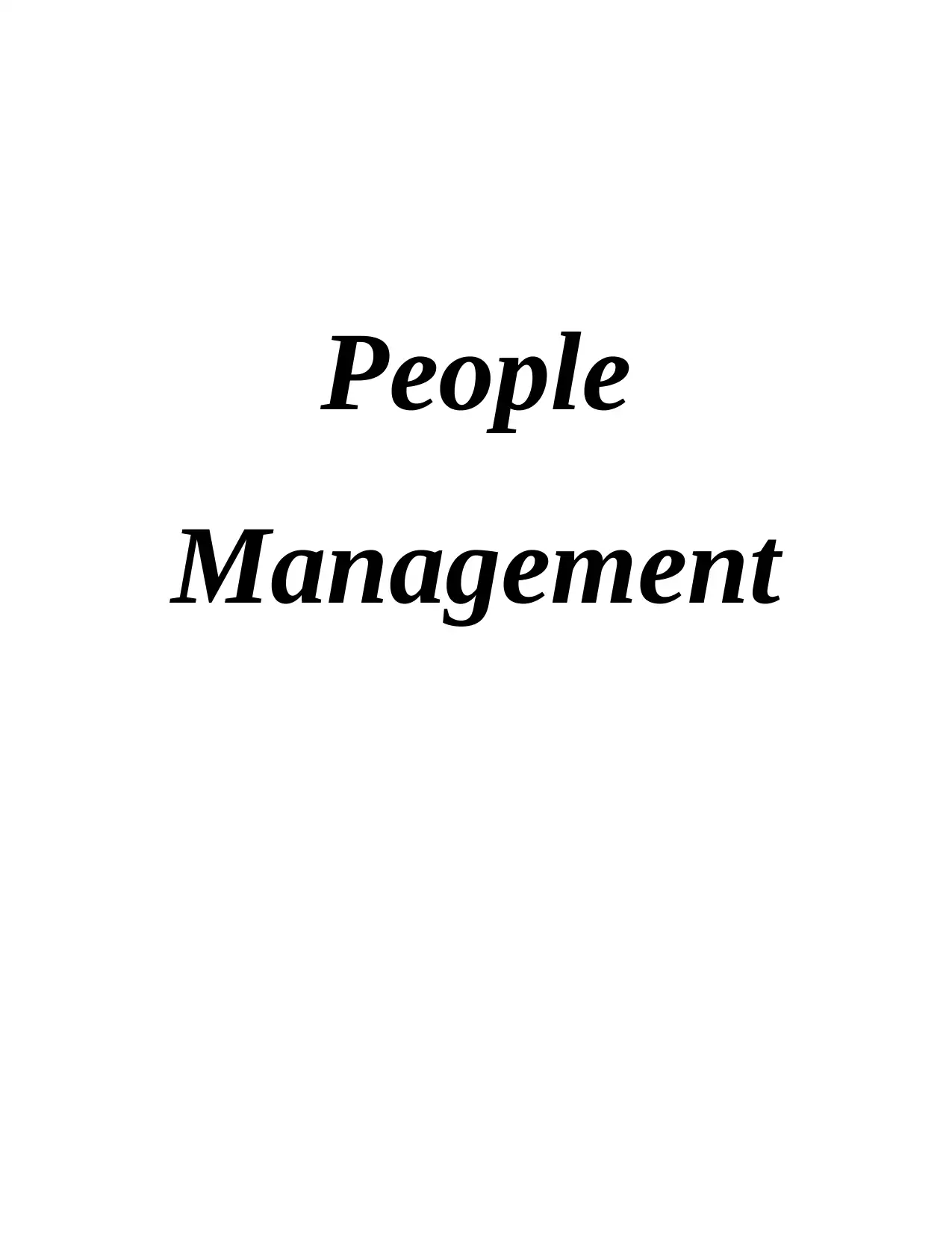
People
Management
Management
Paraphrase This Document
Need a fresh take? Get an instant paraphrase of this document with our AI Paraphraser
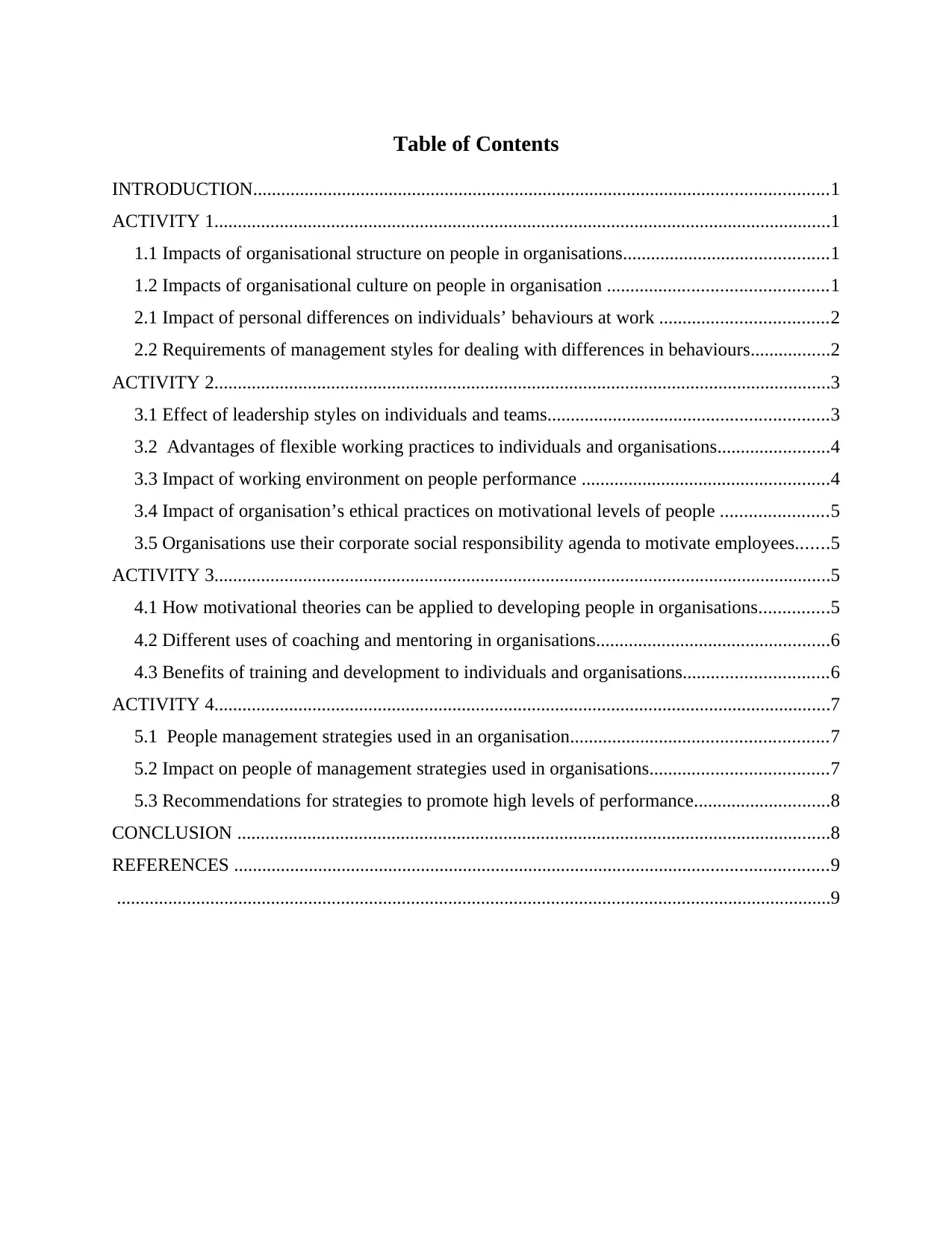
Table of Contents
INTRODUCTION...........................................................................................................................1
ACTIVITY 1....................................................................................................................................1
1.1 Impacts of organisational structure on people in organisations............................................1
1.2 Impacts of organisational culture on people in organisation ...............................................1
2.1 Impact of personal differences on individuals’ behaviours at work ....................................2
2.2 Requirements of management styles for dealing with differences in behaviours.................2
ACTIVITY 2....................................................................................................................................3
3.1 Effect of leadership styles on individuals and teams............................................................3
3.2 Advantages of flexible working practices to individuals and organisations........................4
3.3 Impact of working environment on people performance .....................................................4
3.4 Impact of organisation’s ethical practices on motivational levels of people .......................5
3.5 Organisations use their corporate social responsibility agenda to motivate employees.......5
ACTIVITY 3....................................................................................................................................5
4.1 How motivational theories can be applied to developing people in organisations...............5
4.2 Different uses of coaching and mentoring in organisations..................................................6
4.3 Benefits of training and development to individuals and organisations...............................6
ACTIVITY 4....................................................................................................................................7
5.1 People management strategies used in an organisation.......................................................7
5.2 Impact on people of management strategies used in organisations......................................7
5.3 Recommendations for strategies to promote high levels of performance.............................8
CONCLUSION ...............................................................................................................................8
REFERENCES ...............................................................................................................................9
.........................................................................................................................................................9
INTRODUCTION...........................................................................................................................1
ACTIVITY 1....................................................................................................................................1
1.1 Impacts of organisational structure on people in organisations............................................1
1.2 Impacts of organisational culture on people in organisation ...............................................1
2.1 Impact of personal differences on individuals’ behaviours at work ....................................2
2.2 Requirements of management styles for dealing with differences in behaviours.................2
ACTIVITY 2....................................................................................................................................3
3.1 Effect of leadership styles on individuals and teams............................................................3
3.2 Advantages of flexible working practices to individuals and organisations........................4
3.3 Impact of working environment on people performance .....................................................4
3.4 Impact of organisation’s ethical practices on motivational levels of people .......................5
3.5 Organisations use their corporate social responsibility agenda to motivate employees.......5
ACTIVITY 3....................................................................................................................................5
4.1 How motivational theories can be applied to developing people in organisations...............5
4.2 Different uses of coaching and mentoring in organisations..................................................6
4.3 Benefits of training and development to individuals and organisations...............................6
ACTIVITY 4....................................................................................................................................7
5.1 People management strategies used in an organisation.......................................................7
5.2 Impact on people of management strategies used in organisations......................................7
5.3 Recommendations for strategies to promote high levels of performance.............................8
CONCLUSION ...............................................................................................................................8
REFERENCES ...............................................................................................................................9
.........................................................................................................................................................9

⊘ This is a preview!⊘
Do you want full access?
Subscribe today to unlock all pages.

Trusted by 1+ million students worldwide

INTRODUCTION
People management introduces as the planning, organising, compensating, integrating,
maintaining and retaining people for the motive of contribution to the individual, organisational
and society goals (Balasubramaniam, 2019). This report is based on an individual role in global
business news. This assignment is divided into different activities which are based on managing
people in the organisations. Various approaches will be used for managing people within an
organisation. Number of organisational factors will also followed by an enterprise that have
direct impact on an individual and teams performance. Along with this, there is requirement of
different methods for developing human resource that will also cover in this project. Number of
strategies will also used by companies for managing people within an organisation.
ACTIVITY 1
1.1 Impacts of organisational structure on people in organisations
Organisational structure refers as a system that outlines how several activities are directed
in order to accomplish the goals and objectives of an enterprise. These activities mainly related
with the roles and responsibilities of an individual. There are mainly four types of organisational
structure such as functional, matrix, flat and divisional. These types of structures have direct
impact on people within an organisation. There are some examples of organisational structures
and its impact on people will be explained as below:
Functional structure: Tesco followed functional structure that helps people to feel
confident regarding what they are doing because it is standardized. This structure is also impact
on people by enhancing its work productivity and efficiency due to specialized technology and
skills.
Flat structure: Nike followed flat structure that have direct impact on people as it
elevates the responsibility level of employees in the organisation. It removes additional layers of
administration and enhances the speed of communication and coordination between employees
(Capaul, 2019).
1.2 Impacts of organisational culture on people in organisation
Organisational culture refers as a system of shared values, beliefs and assumptions which
governs how an individual or group of people behave in organisations. Culture of an organisation
is powerful that have direct impact on sales, recruiting efforts, profits and employee morale in
1
People management introduces as the planning, organising, compensating, integrating,
maintaining and retaining people for the motive of contribution to the individual, organisational
and society goals (Balasubramaniam, 2019). This report is based on an individual role in global
business news. This assignment is divided into different activities which are based on managing
people in the organisations. Various approaches will be used for managing people within an
organisation. Number of organisational factors will also followed by an enterprise that have
direct impact on an individual and teams performance. Along with this, there is requirement of
different methods for developing human resource that will also cover in this project. Number of
strategies will also used by companies for managing people within an organisation.
ACTIVITY 1
1.1 Impacts of organisational structure on people in organisations
Organisational structure refers as a system that outlines how several activities are directed
in order to accomplish the goals and objectives of an enterprise. These activities mainly related
with the roles and responsibilities of an individual. There are mainly four types of organisational
structure such as functional, matrix, flat and divisional. These types of structures have direct
impact on people within an organisation. There are some examples of organisational structures
and its impact on people will be explained as below:
Functional structure: Tesco followed functional structure that helps people to feel
confident regarding what they are doing because it is standardized. This structure is also impact
on people by enhancing its work productivity and efficiency due to specialized technology and
skills.
Flat structure: Nike followed flat structure that have direct impact on people as it
elevates the responsibility level of employees in the organisation. It removes additional layers of
administration and enhances the speed of communication and coordination between employees
(Capaul, 2019).
1.2 Impacts of organisational culture on people in organisation
Organisational culture refers as a system of shared values, beliefs and assumptions which
governs how an individual or group of people behave in organisations. Culture of an organisation
is powerful that have direct impact on sales, recruiting efforts, profits and employee morale in
1
Paraphrase This Document
Need a fresh take? Get an instant paraphrase of this document with our AI Paraphraser
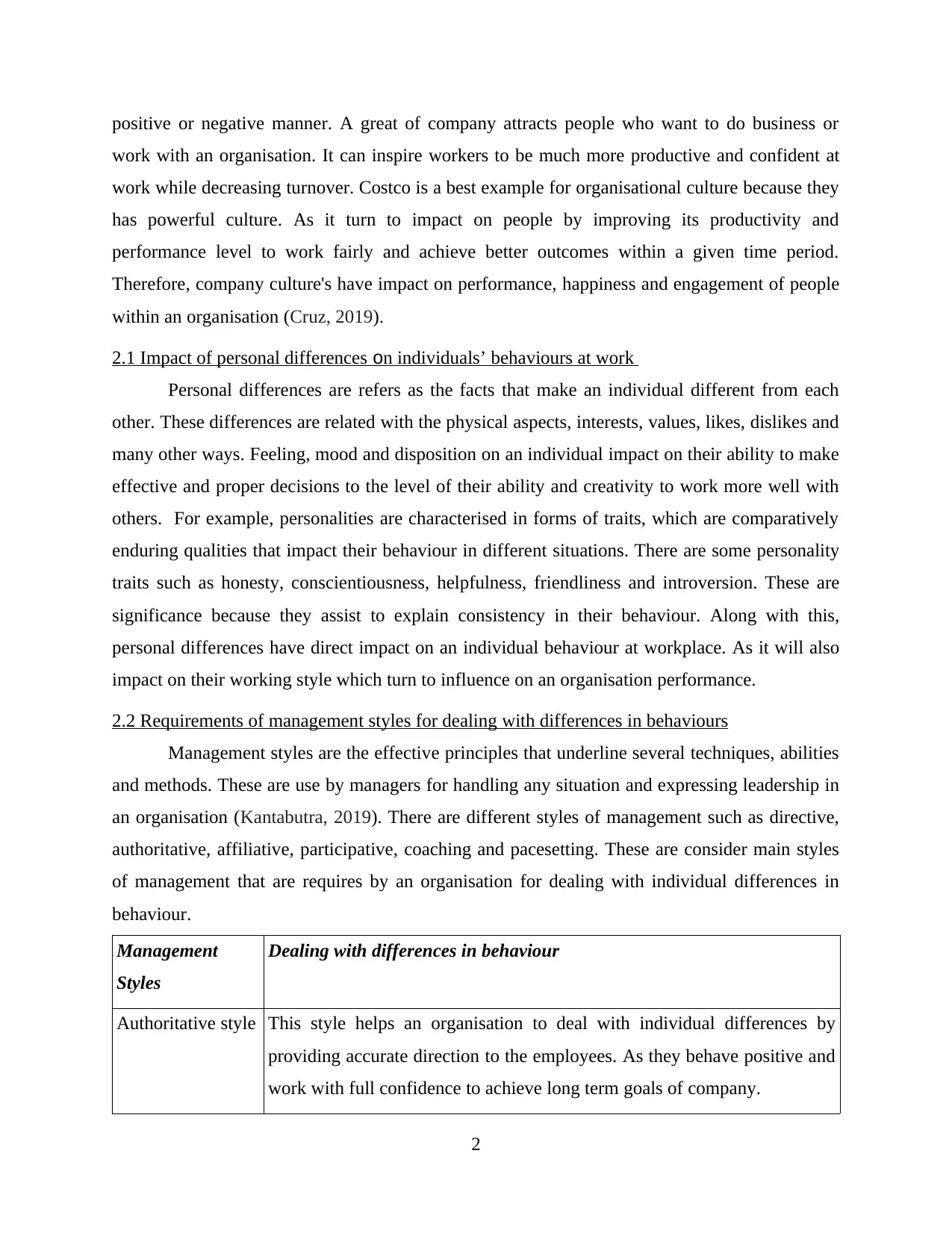
positive or negative manner. A great of company attracts people who want to do business or
work with an organisation. It can inspire workers to be much more productive and confident at
work while decreasing turnover. Costco is a best example for organisational culture because they
has powerful culture. As it turn to impact on people by improving its productivity and
performance level to work fairly and achieve better outcomes within a given time period.
Therefore, company culture's have impact on performance, happiness and engagement of people
within an organisation (Cruz, 2019).
2.1 Impact of personal differences on individuals’ behaviours at work
Personal differences are refers as the facts that make an individual different from each
other. These differences are related with the physical aspects, interests, values, likes, dislikes and
many other ways. Feeling, mood and disposition on an individual impact on their ability to make
effective and proper decisions to the level of their ability and creativity to work more well with
others. For example, personalities are characterised in forms of traits, which are comparatively
enduring qualities that impact their behaviour in different situations. There are some personality
traits such as honesty, conscientiousness, helpfulness, friendliness and introversion. These are
significance because they assist to explain consistency in their behaviour. Along with this,
personal differences have direct impact on an individual behaviour at workplace. As it will also
impact on their working style which turn to influence on an organisation performance.
2.2 Requirements of management styles for dealing with differences in behaviours
Management styles are the effective principles that underline several techniques, abilities
and methods. These are use by managers for handling any situation and expressing leadership in
an organisation (Kantabutra, 2019). There are different styles of management such as directive,
authoritative, affiliative, participative, coaching and pacesetting. These are consider main styles
of management that are requires by an organisation for dealing with individual differences in
behaviour.
Management
Styles
Dealing with differences in behaviour
Authoritative style This style helps an organisation to deal with individual differences by
providing accurate direction to the employees. As they behave positive and
work with full confidence to achieve long term goals of company.
2
work with an organisation. It can inspire workers to be much more productive and confident at
work while decreasing turnover. Costco is a best example for organisational culture because they
has powerful culture. As it turn to impact on people by improving its productivity and
performance level to work fairly and achieve better outcomes within a given time period.
Therefore, company culture's have impact on performance, happiness and engagement of people
within an organisation (Cruz, 2019).
2.1 Impact of personal differences on individuals’ behaviours at work
Personal differences are refers as the facts that make an individual different from each
other. These differences are related with the physical aspects, interests, values, likes, dislikes and
many other ways. Feeling, mood and disposition on an individual impact on their ability to make
effective and proper decisions to the level of their ability and creativity to work more well with
others. For example, personalities are characterised in forms of traits, which are comparatively
enduring qualities that impact their behaviour in different situations. There are some personality
traits such as honesty, conscientiousness, helpfulness, friendliness and introversion. These are
significance because they assist to explain consistency in their behaviour. Along with this,
personal differences have direct impact on an individual behaviour at workplace. As it will also
impact on their working style which turn to influence on an organisation performance.
2.2 Requirements of management styles for dealing with differences in behaviours
Management styles are the effective principles that underline several techniques, abilities
and methods. These are use by managers for handling any situation and expressing leadership in
an organisation (Kantabutra, 2019). There are different styles of management such as directive,
authoritative, affiliative, participative, coaching and pacesetting. These are consider main styles
of management that are requires by an organisation for dealing with individual differences in
behaviour.
Management
Styles
Dealing with differences in behaviour
Authoritative style This style helps an organisation to deal with individual differences by
providing accurate direction to the employees. As they behave positive and
work with full confidence to achieve long term goals of company.
2
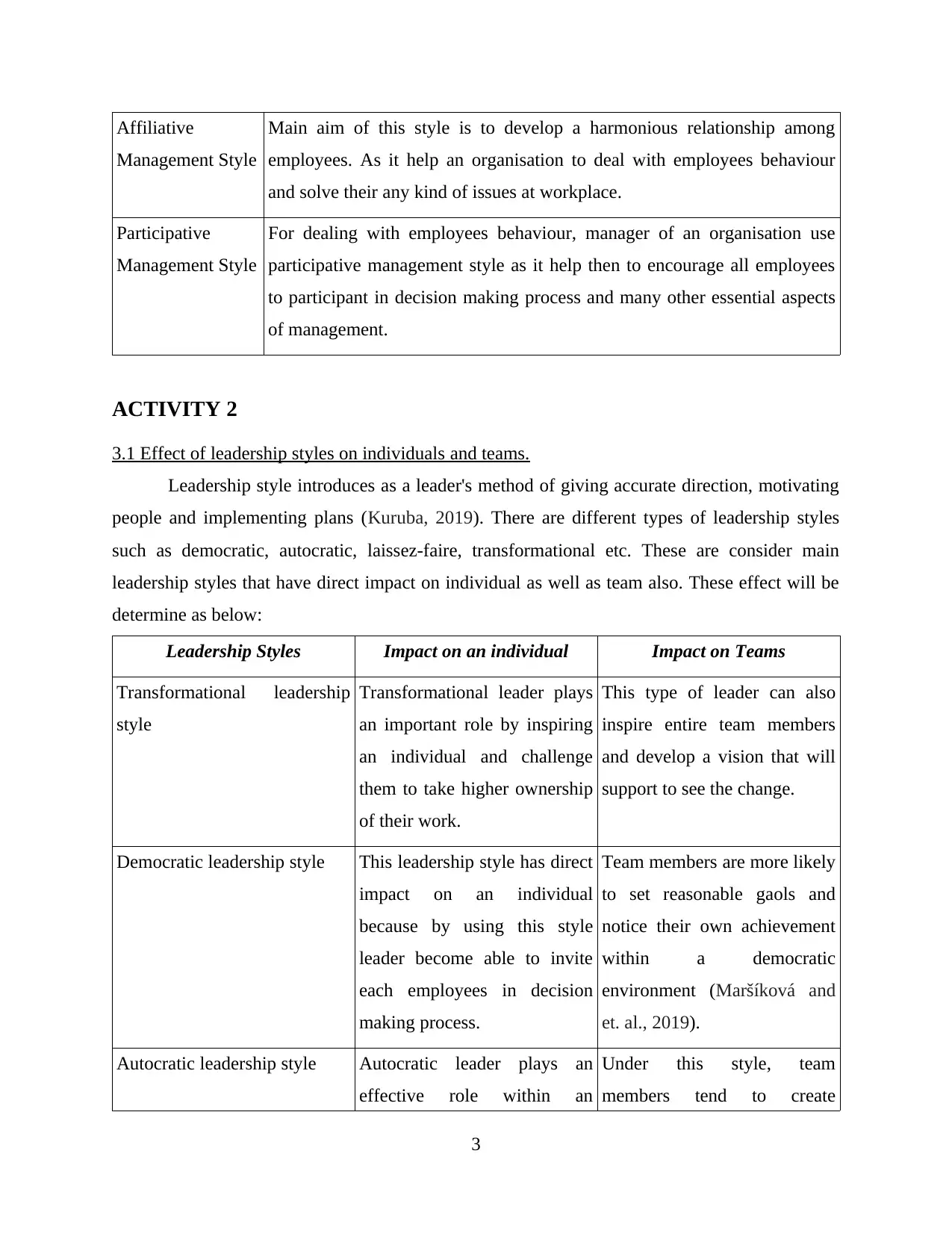
Affiliative
Management Style
Main aim of this style is to develop a harmonious relationship among
employees. As it help an organisation to deal with employees behaviour
and solve their any kind of issues at workplace.
Participative
Management Style
For dealing with employees behaviour, manager of an organisation use
participative management style as it help then to encourage all employees
to participant in decision making process and many other essential aspects
of management.
ACTIVITY 2
3.1 Effect of leadership styles on individuals and teams.
Leadership style introduces as a leader's method of giving accurate direction, motivating
people and implementing plans (Kuruba, 2019). There are different types of leadership styles
such as democratic, autocratic, laissez-faire, transformational etc. These are consider main
leadership styles that have direct impact on individual as well as team also. These effect will be
determine as below:
Leadership Styles Impact on an individual Impact on Teams
Transformational leadership
style
Transformational leader plays
an important role by inspiring
an individual and challenge
them to take higher ownership
of their work.
This type of leader can also
inspire entire team members
and develop a vision that will
support to see the change.
Democratic leadership style This leadership style has direct
impact on an individual
because by using this style
leader become able to invite
each employees in decision
making process.
Team members are more likely
to set reasonable gaols and
notice their own achievement
within a democratic
environment (Maršíková and
et. al., 2019).
Autocratic leadership style Autocratic leader plays an
effective role within an
Under this style, team
members tend to create
3
Management Style
Main aim of this style is to develop a harmonious relationship among
employees. As it help an organisation to deal with employees behaviour
and solve their any kind of issues at workplace.
Participative
Management Style
For dealing with employees behaviour, manager of an organisation use
participative management style as it help then to encourage all employees
to participant in decision making process and many other essential aspects
of management.
ACTIVITY 2
3.1 Effect of leadership styles on individuals and teams.
Leadership style introduces as a leader's method of giving accurate direction, motivating
people and implementing plans (Kuruba, 2019). There are different types of leadership styles
such as democratic, autocratic, laissez-faire, transformational etc. These are consider main
leadership styles that have direct impact on individual as well as team also. These effect will be
determine as below:
Leadership Styles Impact on an individual Impact on Teams
Transformational leadership
style
Transformational leader plays
an important role by inspiring
an individual and challenge
them to take higher ownership
of their work.
This type of leader can also
inspire entire team members
and develop a vision that will
support to see the change.
Democratic leadership style This leadership style has direct
impact on an individual
because by using this style
leader become able to invite
each employees in decision
making process.
Team members are more likely
to set reasonable gaols and
notice their own achievement
within a democratic
environment (Maršíková and
et. al., 2019).
Autocratic leadership style Autocratic leader plays an
effective role within an
Under this style, team
members tend to create
3
⊘ This is a preview!⊘
Do you want full access?
Subscribe today to unlock all pages.

Trusted by 1+ million students worldwide

organisation. As they improves
productivity level of individual
by providing accurate
communication about the
business task.
resentment for the autocratic
leader because they feel or
observe as if they have no say
in making any kind of
decision.
3.2 Advantages of flexible working practices to individuals and organisations.
It is a type of working arrangement that provides a level of flexibility or facility on how
long, when, where and at what times an individual work. There are different practices of flexible
working such as work from home, telecommuting, remote working customized working hours,
part-time positions, job sharing etc. These are consider main practices that helps an individual
and organisation by enhancing their productivity level (Mascarenhas, 2019). There are some
advantages of flexible working practices to an organisation as well as an individual also. These
are explained as below:
Advantages to an individual:
Option of flexible working will help employees to feel more relax and work towards
achievement of long term goals and objectives.
Flexible working practices will also support an individual or employees to boost their
morale and reduce absenteeism.
Advantages to an organisation:
It is cost cost efficient and effective for an organisation.
An improved company culture.
Location independent hiring
Increased loyalty and reduced turnover
3.3 Impact of working environment on people performance
A good working environment introduces as an important and significance elements in
making employees feel good and happy. Friendly and effective working environment helps an
organisation to make employees more happy (McFadyen, 2019). Effective working environment
also support an organisation to improve productivity and performance of employees. As it
support them to maintain better relationship with employees and also retain them for longer time
4
productivity level of individual
by providing accurate
communication about the
business task.
resentment for the autocratic
leader because they feel or
observe as if they have no say
in making any kind of
decision.
3.2 Advantages of flexible working practices to individuals and organisations.
It is a type of working arrangement that provides a level of flexibility or facility on how
long, when, where and at what times an individual work. There are different practices of flexible
working such as work from home, telecommuting, remote working customized working hours,
part-time positions, job sharing etc. These are consider main practices that helps an individual
and organisation by enhancing their productivity level (Mascarenhas, 2019). There are some
advantages of flexible working practices to an organisation as well as an individual also. These
are explained as below:
Advantages to an individual:
Option of flexible working will help employees to feel more relax and work towards
achievement of long term goals and objectives.
Flexible working practices will also support an individual or employees to boost their
morale and reduce absenteeism.
Advantages to an organisation:
It is cost cost efficient and effective for an organisation.
An improved company culture.
Location independent hiring
Increased loyalty and reduced turnover
3.3 Impact of working environment on people performance
A good working environment introduces as an important and significance elements in
making employees feel good and happy. Friendly and effective working environment helps an
organisation to make employees more happy (McFadyen, 2019). Effective working environment
also support an organisation to improve productivity and performance of employees. As it
support them to maintain better relationship with employees and also retain them for longer time
4
Paraphrase This Document
Need a fresh take? Get an instant paraphrase of this document with our AI Paraphraser
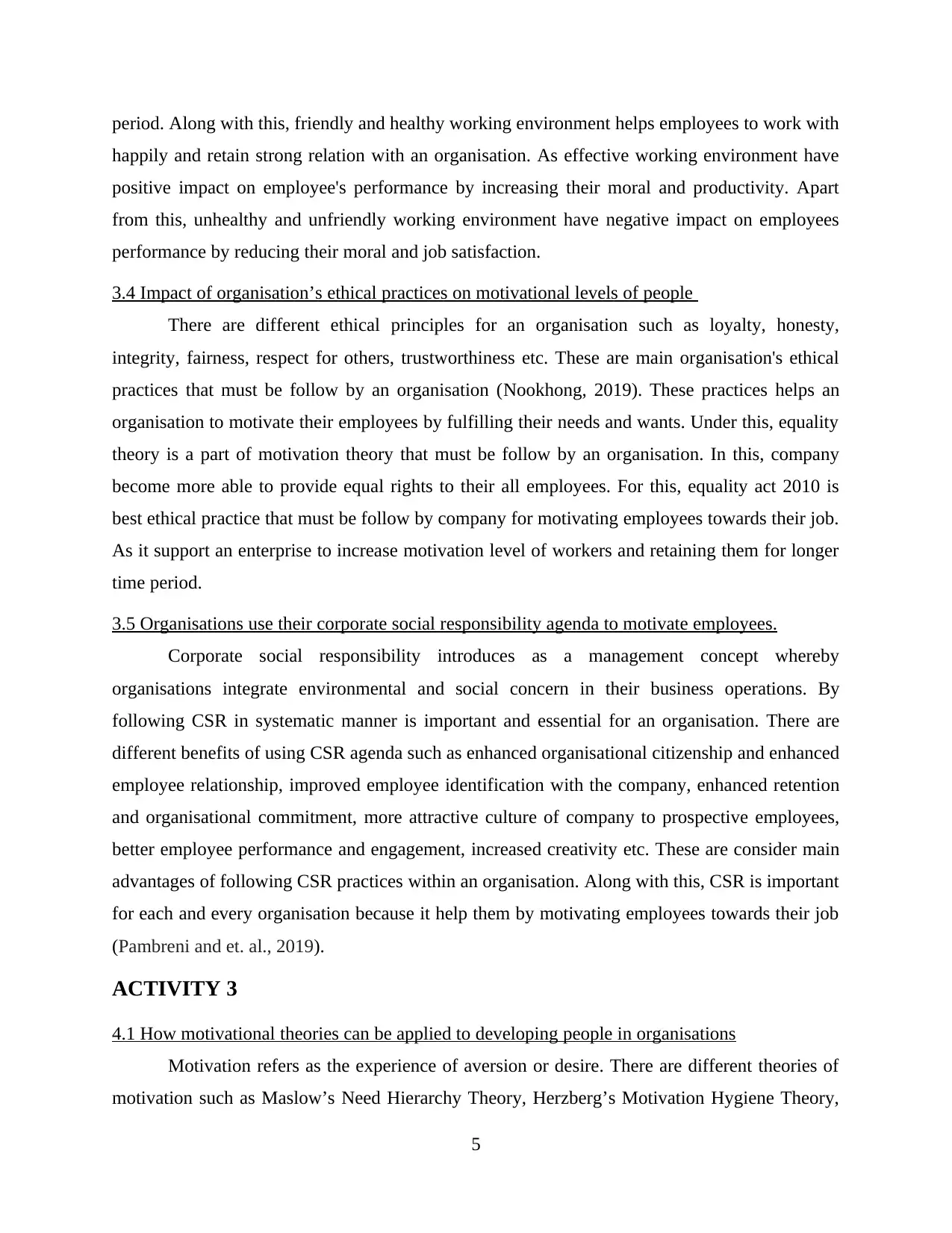
period. Along with this, friendly and healthy working environment helps employees to work with
happily and retain strong relation with an organisation. As effective working environment have
positive impact on employee's performance by increasing their moral and productivity. Apart
from this, unhealthy and unfriendly working environment have negative impact on employees
performance by reducing their moral and job satisfaction.
3.4 Impact of organisation’s ethical practices on motivational levels of people
There are different ethical principles for an organisation such as loyalty, honesty,
integrity, fairness, respect for others, trustworthiness etc. These are main organisation's ethical
practices that must be follow by an organisation (Nookhong, 2019). These practices helps an
organisation to motivate their employees by fulfilling their needs and wants. Under this, equality
theory is a part of motivation theory that must be follow by an organisation. In this, company
become more able to provide equal rights to their all employees. For this, equality act 2010 is
best ethical practice that must be follow by company for motivating employees towards their job.
As it support an enterprise to increase motivation level of workers and retaining them for longer
time period.
3.5 Organisations use their corporate social responsibility agenda to motivate employees.
Corporate social responsibility introduces as a management concept whereby
organisations integrate environmental and social concern in their business operations. By
following CSR in systematic manner is important and essential for an organisation. There are
different benefits of using CSR agenda such as enhanced organisational citizenship and enhanced
employee relationship, improved employee identification with the company, enhanced retention
and organisational commitment, more attractive culture of company to prospective employees,
better employee performance and engagement, increased creativity etc. These are consider main
advantages of following CSR practices within an organisation. Along with this, CSR is important
for each and every organisation because it help them by motivating employees towards their job
(Pambreni and et. al., 2019).
ACTIVITY 3
4.1 How motivational theories can be applied to developing people in organisations
Motivation refers as the experience of aversion or desire. There are different theories of
motivation such as Maslow’s Need Hierarchy Theory, Herzberg’s Motivation Hygiene Theory,
5
happily and retain strong relation with an organisation. As effective working environment have
positive impact on employee's performance by increasing their moral and productivity. Apart
from this, unhealthy and unfriendly working environment have negative impact on employees
performance by reducing their moral and job satisfaction.
3.4 Impact of organisation’s ethical practices on motivational levels of people
There are different ethical principles for an organisation such as loyalty, honesty,
integrity, fairness, respect for others, trustworthiness etc. These are main organisation's ethical
practices that must be follow by an organisation (Nookhong, 2019). These practices helps an
organisation to motivate their employees by fulfilling their needs and wants. Under this, equality
theory is a part of motivation theory that must be follow by an organisation. In this, company
become more able to provide equal rights to their all employees. For this, equality act 2010 is
best ethical practice that must be follow by company for motivating employees towards their job.
As it support an enterprise to increase motivation level of workers and retaining them for longer
time period.
3.5 Organisations use their corporate social responsibility agenda to motivate employees.
Corporate social responsibility introduces as a management concept whereby
organisations integrate environmental and social concern in their business operations. By
following CSR in systematic manner is important and essential for an organisation. There are
different benefits of using CSR agenda such as enhanced organisational citizenship and enhanced
employee relationship, improved employee identification with the company, enhanced retention
and organisational commitment, more attractive culture of company to prospective employees,
better employee performance and engagement, increased creativity etc. These are consider main
advantages of following CSR practices within an organisation. Along with this, CSR is important
for each and every organisation because it help them by motivating employees towards their job
(Pambreni and et. al., 2019).
ACTIVITY 3
4.1 How motivational theories can be applied to developing people in organisations
Motivation refers as the experience of aversion or desire. There are different theories of
motivation such as Maslow’s Need Hierarchy Theory, Herzberg’s Motivation Hygiene Theory,
5
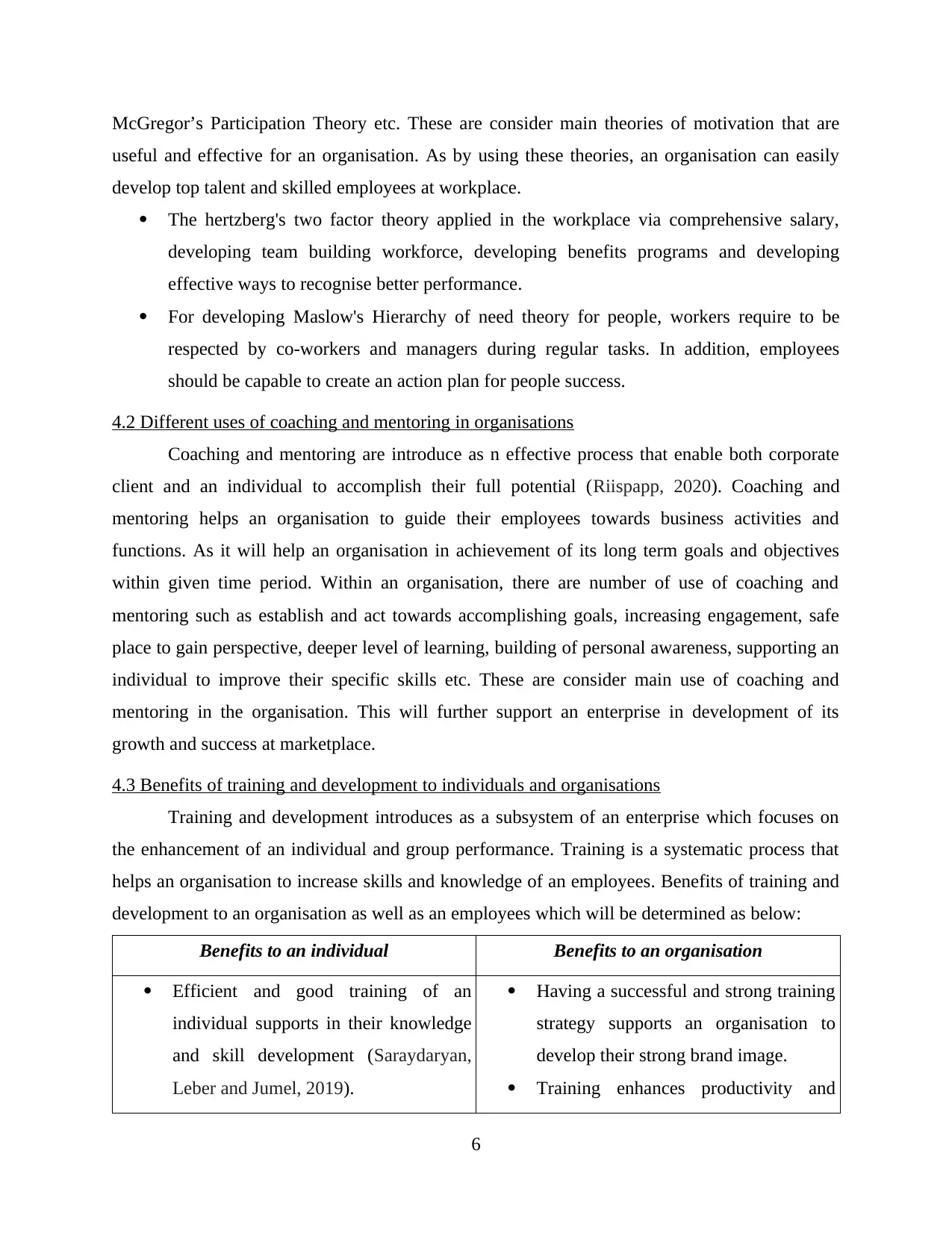
McGregor’s Participation Theory etc. These are consider main theories of motivation that are
useful and effective for an organisation. As by using these theories, an organisation can easily
develop top talent and skilled employees at workplace.
The hertzberg's two factor theory applied in the workplace via comprehensive salary,
developing team building workforce, developing benefits programs and developing
effective ways to recognise better performance.
For developing Maslow's Hierarchy of need theory for people, workers require to be
respected by co-workers and managers during regular tasks. In addition, employees
should be capable to create an action plan for people success.
4.2 Different uses of coaching and mentoring in organisations
Coaching and mentoring are introduce as n effective process that enable both corporate
client and an individual to accomplish their full potential (Riispapp, 2020). Coaching and
mentoring helps an organisation to guide their employees towards business activities and
functions. As it will help an organisation in achievement of its long term goals and objectives
within given time period. Within an organisation, there are number of use of coaching and
mentoring such as establish and act towards accomplishing goals, increasing engagement, safe
place to gain perspective, deeper level of learning, building of personal awareness, supporting an
individual to improve their specific skills etc. These are consider main use of coaching and
mentoring in the organisation. This will further support an enterprise in development of its
growth and success at marketplace.
4.3 Benefits of training and development to individuals and organisations
Training and development introduces as a subsystem of an enterprise which focuses on
the enhancement of an individual and group performance. Training is a systematic process that
helps an organisation to increase skills and knowledge of an employees. Benefits of training and
development to an organisation as well as an employees which will be determined as below:
Benefits to an individual Benefits to an organisation
Efficient and good training of an
individual supports in their knowledge
and skill development (Saraydaryan,
Leber and Jumel, 2019).
Having a successful and strong training
strategy supports an organisation to
develop their strong brand image.
Training enhances productivity and
6
useful and effective for an organisation. As by using these theories, an organisation can easily
develop top talent and skilled employees at workplace.
The hertzberg's two factor theory applied in the workplace via comprehensive salary,
developing team building workforce, developing benefits programs and developing
effective ways to recognise better performance.
For developing Maslow's Hierarchy of need theory for people, workers require to be
respected by co-workers and managers during regular tasks. In addition, employees
should be capable to create an action plan for people success.
4.2 Different uses of coaching and mentoring in organisations
Coaching and mentoring are introduce as n effective process that enable both corporate
client and an individual to accomplish their full potential (Riispapp, 2020). Coaching and
mentoring helps an organisation to guide their employees towards business activities and
functions. As it will help an organisation in achievement of its long term goals and objectives
within given time period. Within an organisation, there are number of use of coaching and
mentoring such as establish and act towards accomplishing goals, increasing engagement, safe
place to gain perspective, deeper level of learning, building of personal awareness, supporting an
individual to improve their specific skills etc. These are consider main use of coaching and
mentoring in the organisation. This will further support an enterprise in development of its
growth and success at marketplace.
4.3 Benefits of training and development to individuals and organisations
Training and development introduces as a subsystem of an enterprise which focuses on
the enhancement of an individual and group performance. Training is a systematic process that
helps an organisation to increase skills and knowledge of an employees. Benefits of training and
development to an organisation as well as an employees which will be determined as below:
Benefits to an individual Benefits to an organisation
Efficient and good training of an
individual supports in their knowledge
and skill development (Saraydaryan,
Leber and Jumel, 2019).
Having a successful and strong training
strategy supports an organisation to
develop their strong brand image.
Training enhances productivity and
6
⊘ This is a preview!⊘
Do you want full access?
Subscribe today to unlock all pages.

Trusted by 1+ million students worldwide
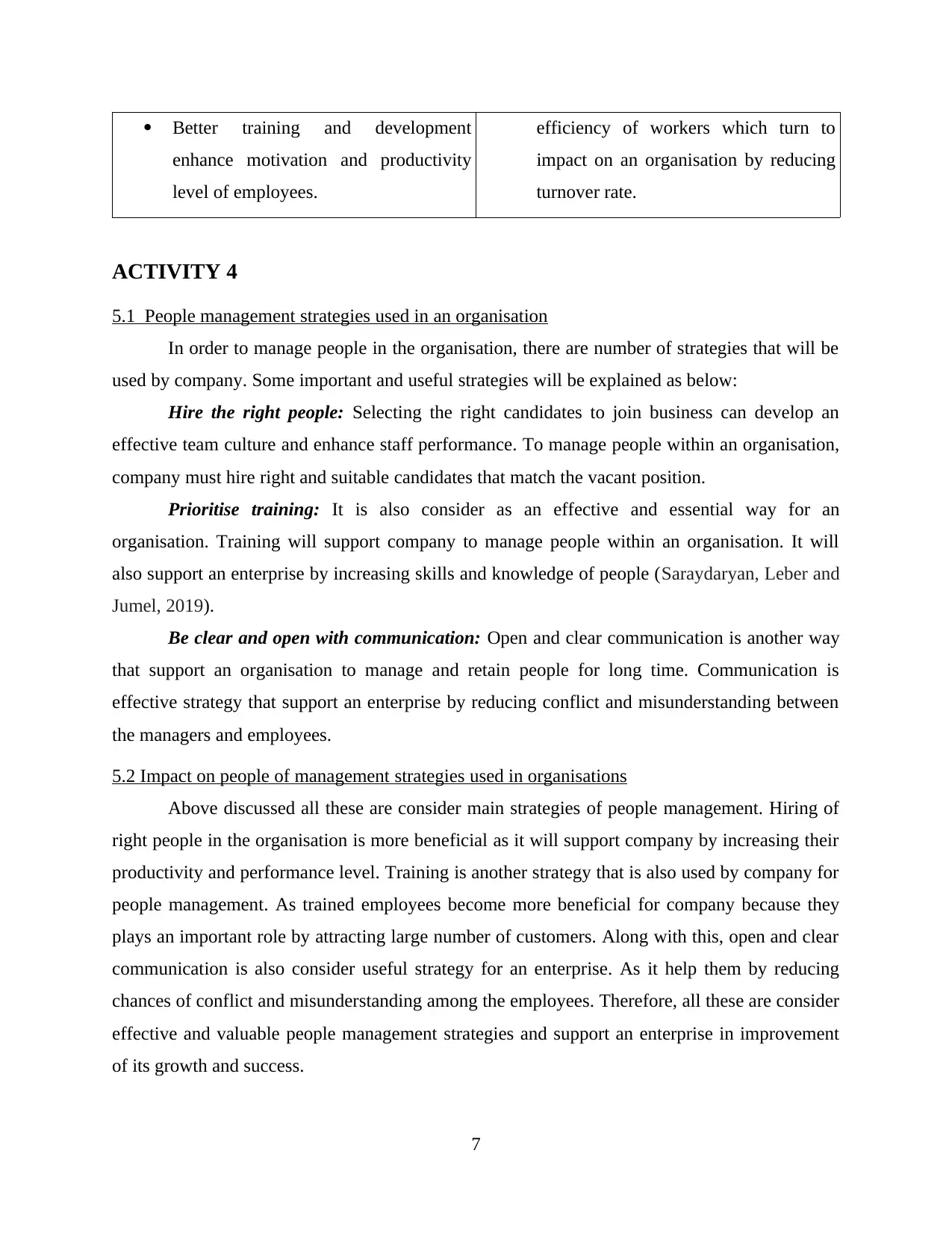
Better training and development
enhance motivation and productivity
level of employees.
efficiency of workers which turn to
impact on an organisation by reducing
turnover rate.
ACTIVITY 4
5.1 People management strategies used in an organisation
In order to manage people in the organisation, there are number of strategies that will be
used by company. Some important and useful strategies will be explained as below:
Hire the right people: Selecting the right candidates to join business can develop an
effective team culture and enhance staff performance. To manage people within an organisation,
company must hire right and suitable candidates that match the vacant position.
Prioritise training: It is also consider as an effective and essential way for an
organisation. Training will support company to manage people within an organisation. It will
also support an enterprise by increasing skills and knowledge of people (Saraydaryan, Leber and
Jumel, 2019).
Be clear and open with communication: Open and clear communication is another way
that support an organisation to manage and retain people for long time. Communication is
effective strategy that support an enterprise by reducing conflict and misunderstanding between
the managers and employees.
5.2 Impact on people of management strategies used in organisations
Above discussed all these are consider main strategies of people management. Hiring of
right people in the organisation is more beneficial as it will support company by increasing their
productivity and performance level. Training is another strategy that is also used by company for
people management. As trained employees become more beneficial for company because they
plays an important role by attracting large number of customers. Along with this, open and clear
communication is also consider useful strategy for an enterprise. As it help them by reducing
chances of conflict and misunderstanding among the employees. Therefore, all these are consider
effective and valuable people management strategies and support an enterprise in improvement
of its growth and success.
7
enhance motivation and productivity
level of employees.
efficiency of workers which turn to
impact on an organisation by reducing
turnover rate.
ACTIVITY 4
5.1 People management strategies used in an organisation
In order to manage people in the organisation, there are number of strategies that will be
used by company. Some important and useful strategies will be explained as below:
Hire the right people: Selecting the right candidates to join business can develop an
effective team culture and enhance staff performance. To manage people within an organisation,
company must hire right and suitable candidates that match the vacant position.
Prioritise training: It is also consider as an effective and essential way for an
organisation. Training will support company to manage people within an organisation. It will
also support an enterprise by increasing skills and knowledge of people (Saraydaryan, Leber and
Jumel, 2019).
Be clear and open with communication: Open and clear communication is another way
that support an organisation to manage and retain people for long time. Communication is
effective strategy that support an enterprise by reducing conflict and misunderstanding between
the managers and employees.
5.2 Impact on people of management strategies used in organisations
Above discussed all these are consider main strategies of people management. Hiring of
right people in the organisation is more beneficial as it will support company by increasing their
productivity and performance level. Training is another strategy that is also used by company for
people management. As trained employees become more beneficial for company because they
plays an important role by attracting large number of customers. Along with this, open and clear
communication is also consider useful strategy for an enterprise. As it help them by reducing
chances of conflict and misunderstanding among the employees. Therefore, all these are consider
effective and valuable people management strategies and support an enterprise in improvement
of its growth and success.
7
Paraphrase This Document
Need a fresh take? Get an instant paraphrase of this document with our AI Paraphraser
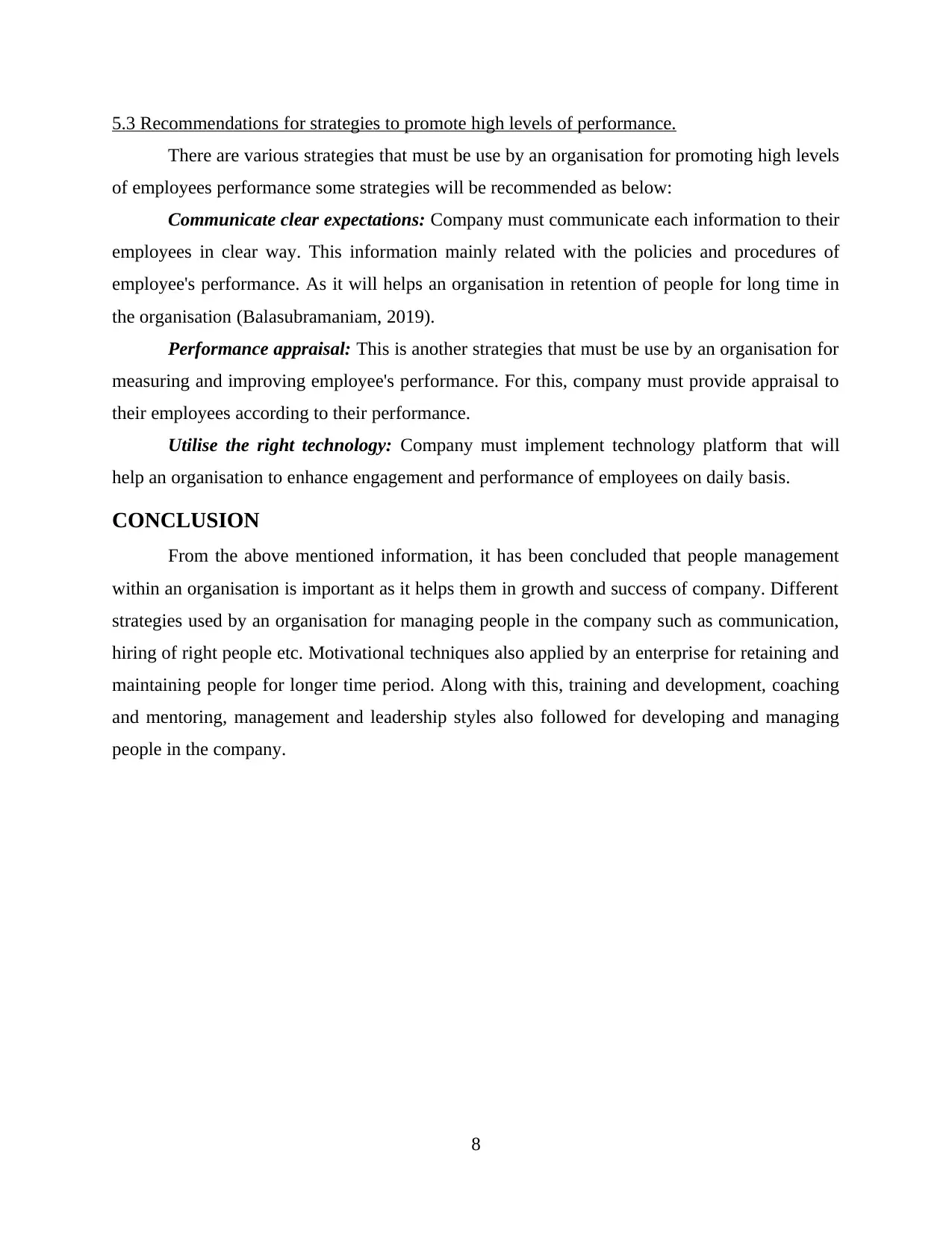
5.3 Recommendations for strategies to promote high levels of performance.
There are various strategies that must be use by an organisation for promoting high levels
of employees performance some strategies will be recommended as below:
Communicate clear expectations: Company must communicate each information to their
employees in clear way. This information mainly related with the policies and procedures of
employee's performance. As it will helps an organisation in retention of people for long time in
the organisation (Balasubramaniam, 2019).
Performance appraisal: This is another strategies that must be use by an organisation for
measuring and improving employee's performance. For this, company must provide appraisal to
their employees according to their performance.
Utilise the right technology: Company must implement technology platform that will
help an organisation to enhance engagement and performance of employees on daily basis.
CONCLUSION
From the above mentioned information, it has been concluded that people management
within an organisation is important as it helps them in growth and success of company. Different
strategies used by an organisation for managing people in the company such as communication,
hiring of right people etc. Motivational techniques also applied by an enterprise for retaining and
maintaining people for longer time period. Along with this, training and development, coaching
and mentoring, management and leadership styles also followed for developing and managing
people in the company.
8
There are various strategies that must be use by an organisation for promoting high levels
of employees performance some strategies will be recommended as below:
Communicate clear expectations: Company must communicate each information to their
employees in clear way. This information mainly related with the policies and procedures of
employee's performance. As it will helps an organisation in retention of people for long time in
the organisation (Balasubramaniam, 2019).
Performance appraisal: This is another strategies that must be use by an organisation for
measuring and improving employee's performance. For this, company must provide appraisal to
their employees according to their performance.
Utilise the right technology: Company must implement technology platform that will
help an organisation to enhance engagement and performance of employees on daily basis.
CONCLUSION
From the above mentioned information, it has been concluded that people management
within an organisation is important as it helps them in growth and success of company. Different
strategies used by an organisation for managing people in the company such as communication,
hiring of right people etc. Motivational techniques also applied by an enterprise for retaining and
maintaining people for longer time period. Along with this, training and development, coaching
and mentoring, management and leadership styles also followed for developing and managing
people in the company.
8
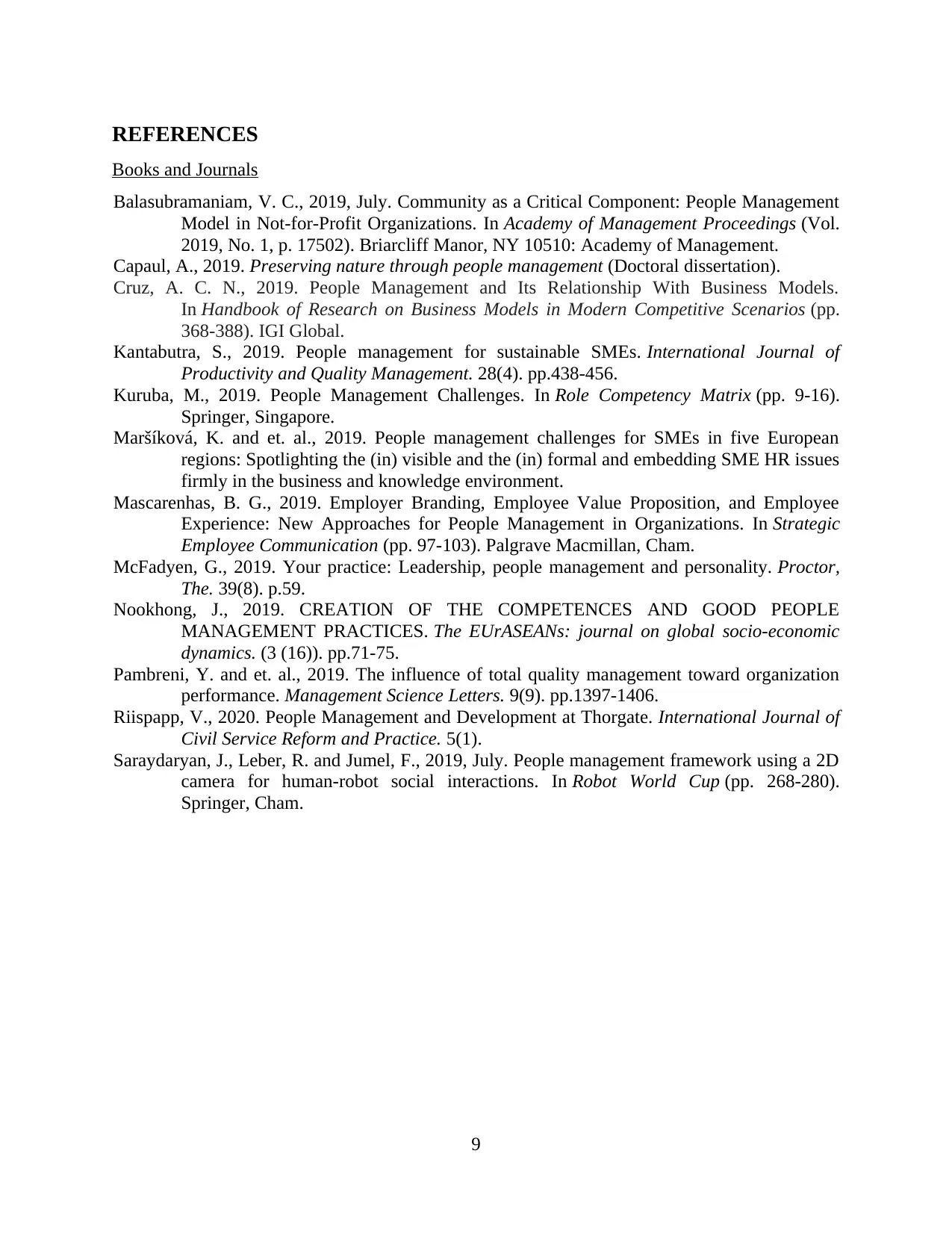
REFERENCES
Books and Journals
Balasubramaniam, V. C., 2019, July. Community as a Critical Component: People Management
Model in Not-for-Profit Organizations. In Academy of Management Proceedings (Vol.
2019, No. 1, p. 17502). Briarcliff Manor, NY 10510: Academy of Management.
Capaul, A., 2019. Preserving nature through people management (Doctoral dissertation).
Cruz, A. C. N., 2019. People Management and Its Relationship With Business Models.
In Handbook of Research on Business Models in Modern Competitive Scenarios (pp.
368-388). IGI Global.
Kantabutra, S., 2019. People management for sustainable SMEs. International Journal of
Productivity and Quality Management. 28(4). pp.438-456.
Kuruba, M., 2019. People Management Challenges. In Role Competency Matrix (pp. 9-16).
Springer, Singapore.
Maršíková, K. and et. al., 2019. People management challenges for SMEs in five European
regions: Spotlighting the (in) visible and the (in) formal and embedding SME HR issues
firmly in the business and knowledge environment.
Mascarenhas, B. G., 2019. Employer Branding, Employee Value Proposition, and Employee
Experience: New Approaches for People Management in Organizations. In Strategic
Employee Communication (pp. 97-103). Palgrave Macmillan, Cham.
McFadyen, G., 2019. Your practice: Leadership, people management and personality. Proctor,
The. 39(8). p.59.
Nookhong, J., 2019. CREATION OF THE COMPETENCES AND GOOD PEOPLE
MANAGEMENT PRACTICES. The EUrASEANs: journal on global socio-economic
dynamics. (3 (16)). pp.71-75.
Pambreni, Y. and et. al., 2019. The influence of total quality management toward organization
performance. Management Science Letters. 9(9). pp.1397-1406.
Riispapp, V., 2020. People Management and Development at Thorgate. International Journal of
Civil Service Reform and Practice. 5(1).
Saraydaryan, J., Leber, R. and Jumel, F., 2019, July. People management framework using a 2D
camera for human-robot social interactions. In Robot World Cup (pp. 268-280).
Springer, Cham.
9
Books and Journals
Balasubramaniam, V. C., 2019, July. Community as a Critical Component: People Management
Model in Not-for-Profit Organizations. In Academy of Management Proceedings (Vol.
2019, No. 1, p. 17502). Briarcliff Manor, NY 10510: Academy of Management.
Capaul, A., 2019. Preserving nature through people management (Doctoral dissertation).
Cruz, A. C. N., 2019. People Management and Its Relationship With Business Models.
In Handbook of Research on Business Models in Modern Competitive Scenarios (pp.
368-388). IGI Global.
Kantabutra, S., 2019. People management for sustainable SMEs. International Journal of
Productivity and Quality Management. 28(4). pp.438-456.
Kuruba, M., 2019. People Management Challenges. In Role Competency Matrix (pp. 9-16).
Springer, Singapore.
Maršíková, K. and et. al., 2019. People management challenges for SMEs in five European
regions: Spotlighting the (in) visible and the (in) formal and embedding SME HR issues
firmly in the business and knowledge environment.
Mascarenhas, B. G., 2019. Employer Branding, Employee Value Proposition, and Employee
Experience: New Approaches for People Management in Organizations. In Strategic
Employee Communication (pp. 97-103). Palgrave Macmillan, Cham.
McFadyen, G., 2019. Your practice: Leadership, people management and personality. Proctor,
The. 39(8). p.59.
Nookhong, J., 2019. CREATION OF THE COMPETENCES AND GOOD PEOPLE
MANAGEMENT PRACTICES. The EUrASEANs: journal on global socio-economic
dynamics. (3 (16)). pp.71-75.
Pambreni, Y. and et. al., 2019. The influence of total quality management toward organization
performance. Management Science Letters. 9(9). pp.1397-1406.
Riispapp, V., 2020. People Management and Development at Thorgate. International Journal of
Civil Service Reform and Practice. 5(1).
Saraydaryan, J., Leber, R. and Jumel, F., 2019, July. People management framework using a 2D
camera for human-robot social interactions. In Robot World Cup (pp. 268-280).
Springer, Cham.
9
⊘ This is a preview!⊘
Do you want full access?
Subscribe today to unlock all pages.

Trusted by 1+ million students worldwide
1 out of 12
Related Documents
Your All-in-One AI-Powered Toolkit for Academic Success.
+13062052269
info@desklib.com
Available 24*7 on WhatsApp / Email
![[object Object]](/_next/static/media/star-bottom.7253800d.svg)
Unlock your academic potential
Copyright © 2020–2025 A2Z Services. All Rights Reserved. Developed and managed by ZUCOL.





